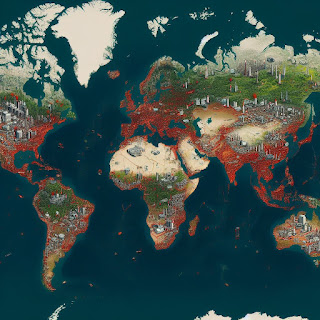As we navigate the intricacies of the 21st century, we must recognize the influential role public sentiment plays in shaping society's progress. By “progress,” I mean the combination of economic, technological, scientific, cultural, and organizational advancement that has transformed our lives and raised standards of living over the past couple of centuries. We will explore the relationship between societal mood, trust in science, and innovation, highlighting historical case studies and data points that emphasize these relationships. By fostering trust in science and promoting a positive public sentiment today, leaders can create an environment conducive to sustainable innovation and societal growth.

Science has always been a formidable catalyst for societal progress. The ancient Greeks, for instance, used rudimentary scientific principles to engineer astounding structures like the Parthenon and pioneered advancements in medicine, mathematics, and astronomy. During the Middle Ages, Arabic scholars preserved and expanded upon the knowledge of the Greeks, contributing to fields such as algebra and optics.
The Scientific Revolution of the 17th century marked a pivotal shift in scientific thought. Galileo's heliocentric model and Newton's laws of motion dismantled established notions of the universe, laying the groundwork for modern physics. The trust placed in their revolutionary ideas, although initially met with resistance, ultimately led to further exploration and discoveries.
The 18th century's Industrial Revolution, spurred by innovations such as James Watt's steam engine, led to mass production and changed the face of economies globally. During the 19th century, Louis Pasteur's germ theory revolutionized medicine, leading to life-saving treatments for previously incurable diseases.
The 20th century saw unprecedented scientific advancements, from the development of antibiotics and vaccines to the creation of the internet. These technological advancements, largely borne out of periods of optimism and societal trust in science, have revolutionized communication, health, and many other facets of our lives.
Research suggests there is a connection between happiness and innovation at both the individual and societal levels. Happiness can foster creativity, which is a fundamental driver of innovation.
History tells us that the road to a better future is accessed through discovery, gaining knowledge and applying it. Sitting still or pining for the past are not the answers. Science helps us gain knowledge on how to improve the human experience and progress. Yet, the road to progress has often been bumpy, with mistrust and misunderstanding casting shadows over scientific advancement. Galileo faced the Inquisition for his revolutionary ideas, and a few years back, the false link between MMR vaccines and autism led to a decline in vaccination rates, and misinformation led to distrust of vaccines during the COVID-19 pandemic which had serious consequences for millions. We will discuss this more later.
The Correlation between Societal Moods and Innovation:
Positive societal moods have often given rise to periods of profound creativity and advancement. For example, the post-World War II economic boom was characterized by societal optimism and trust in science. This period saw a surge in total patent filings – from 91,996 in 1946 to over 316,386 in 1965. It also produced breakthrough inventions such as transistors, mainframe computers, and satellite technology. The optimism of the era and the faith in science allowed these technologies to permeate society quickly, transforming the economic and social landscape.
The Center for Science and the Imagination at Arizona State University even has a mission of encouraging optimistic thinking about the future through fiction and narrative: It observes that imagination and ambition themselves play a large role in shaping our future.
The late 19th century in the United States was marked by a strong faith in the power of reason and technology to improve society.
Conversely, negative public sentiment, often fueled by misinformation, politicians that promote fear for political gain, or economic hardships, can hinder innovation. During the 2008 financial crisis, research and development (R&D) investments took a significant hit, halting the annual growth in patent filings. However, once R&D budgets and optimism returned patent filings rapidly grew from 482,871 in 2009, to 646,855 in 2022.
Challenging times, however, can also serve as a catalyst for innovation. The COVID-19 pandemic, despite its devastating impacts, has accelerated advancements in telemedicine, remote work technologies, and mRNA vaccine development.
The Challenges of Trust in Science in the Age of Misinformation:
In our information-saturated society, misinformation and disinformation pose significant threats to public trust in science. A 2020 report by the National Academies of Sciences, Engineering, and Medicine identified misinformation about science and health as a "significant threat to public health and well-being." One timely example, as mentioned earlier, is the widespread misinformation about vaccines. A study in the Lancet in 1998 falsely linked the MMR vaccine to autism, leading to a decrease in vaccination rates that then led to serious measles outbreaks. Although the paper was later retracted, that misinformation continues to echo around the internet and it continues to impact public trust in vaccinations today.
Climate change is another domain where misinformation has hampered progress. Despite the overwhelming scientific consensus on human-induced climate change, misinformation campaigns have resulted in significant portions of the public doubting its existence or severity, which hinders urgent climate action and we all suffer.
Recommendations:
Leaders play a pivotal role in shaping public sentiment and fostering trust in science. By promoting transparency and encouraging science education, they can enhance public understanding and acceptance of scientific advancements and scientific processes. Science is not about being right the first time. It is a process of learning, gaining knowledge and getting better. It is the story of our human progress.
While science generates much of our prosperity, scientists and researchers themselves do not sufficiently obsess over how it should be organized. ~ Patrick Collison and Tyler Cowen
Politicians that might gain a few points in the polls by promoting fear and an anti-science position must look past personal interests and understand the larger negative impact on society and public health.
Transparency in communication is crucial. For instance, during the 2014 Ebola outbreak, Liberian President Ellen Johnson Sirleaf's regular, transparent updates played a critical role in combating misinformation, maintaining public trust, and managing the crisis effectively.
Investing in science education is another powerful tool. For example, Finland, which boasts one of the world's best education systems, has a strong focus on science education. This focus has not only resulted in high science literacy rates but also a strong public trust in science and a vibrant innovation environment, evidenced by the number of Finnish patents filed and tech companies created.
Leaders should also strive to celebrate scientific achievements and foster collaborations between scientists and communities. The Human Genome Project, a collaborative effort involving scientists from around the world, has had profound impacts on medicine and been widely celebrated, enhancing public trust in science.
Today, leaders must navigate the intricate dynamics of societal moods, trust in science, and innovation. They must strive to foster an environment of positivity and trust, necessary for maximizing the societal benefits of scientific advancement. A Pew Research Center study found a decline in trust in science in the United States, from 73% in 2009 to 58% in 2021. Another concern is that in 2021, 29% of U.S. adults say they have a great deal of confidence in medical scientists to act in the best interests of the public, down from 40% who said this in November 2020. Similarly, the share with a great deal of confidence in scientists to act in the public’s best interests is down by 10 percentage points (from 39% to 29%), according to a new
Pew Research Center survey. Such data underscores the critical need for leaders to cultivate trust in science, given its direct influence on the pace and acceptance of innovation and ultimately our standard of living.
*I use generative AI to assist in all my work.
***Full Disclosure: These are my personal opinions. No company is silly enough to claim them. I work with and have worked with many of the companies mentioned in my articles.



















